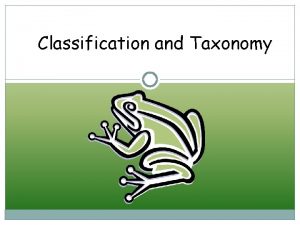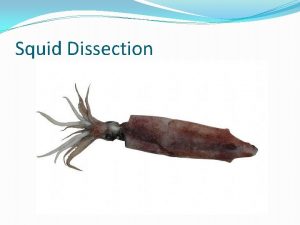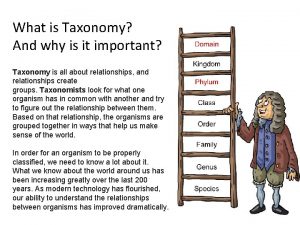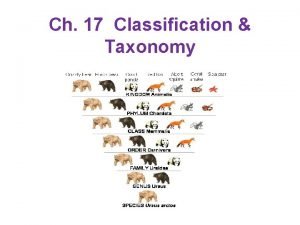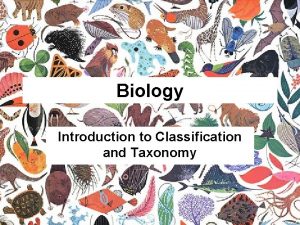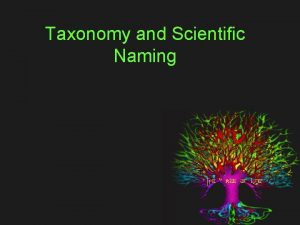CLASSIFICATION TAXONOMY WHY ALL THE GROUPS 2 5



















- Slides: 19

CLASSIFICATION & TAXONOMY

WHY ALL THE GROUPS? • • • 2. 5 million kinds of different species in the world. Still many species we don’t even know about. Estimate that 20 million more are yet to be discovered. Scientist need to keep track of all these animals. To do this, scientist divide living things into manageable groups based on similarities and differences. • The science of naming organisms and assigning them to these groups is called taxonomy. • Biologists who study this are called taxonomists.

WHY CLASSIFY? • Classifying helps us to see relationships, similarities and differences within living organisms. • As living things are constantly being investigated, new attributes are revealed that affect how organisms re placed in a standard classification system. • All organisms fall into one of 3 categories called Domains which then are split into major groups called Kingdoms. • Domains are the broadest taxonomic classification of living organism.

3 DOMAINS • Eukarya: • Organisms that have cells with nuclei • Includes fungi, plants, animals and several Kingdoms of protists • Archaea: • Single-celled organisms without nuclei and include many extremophiles that live in harsh environments like hot springs. • Bacteria • Quite different from Archaea • Single-celled organisms without nuclei

• Both the Archaea and the Bacteria are prokaryotes, an informal name for cells without nuclei. The recognition in the 1990 s that certain “bacteria, ” now known as the Archaea, were as different genetically and biochemically from other bacterial cells as they were from eukaryotes, motivated the recommendation to divide life into three domains.


ORGANISMS ARE GROUPED INTO ONE OF 6 KINGDOMS BASED ON 3 FACTORS: • Cell type (prokaryotic or eukaryotic), cell number (unicellular or multicellular), and feeding type (autotroph or heterotroph). • Cell Type: • The presence or absence of cellular structures such as the nucleus, mitochondria, or a cell wall: • Prokaryotes: do not have a nucleus, no membrane bound organelles • Ex. Bacteria • Eukaryotes: do have an organized nucleus with a membrane, membrane bound organelles • Ex. Protists, Fungi, Animals, Plants

• Cell Number: • Unicellular – single celled organism: protozoans, bacteria, some algae • Multicellular – many celled organism • Cells start to become more specialized and differentiate. They get different “jobs”. • Feeding Type: • Autotroph or producer: make their own food • Heterotroph or consumer: must eat other organisms to survive (includes decomposers)

HIERARCHICAL CLASSIFICATION • Each kingdom consists of a series of subgroups or taxa, in which organisms in each lower taxa share an increasing number of characteristics. • Each of the taxa fit into all of the taxa that are above them.

• Only species exist in nature as biologically cohesive units, bonded by interbreeding and bounded by reproductive isolation from all other species. • Species can be distinguished objectively by using the characteristics unique to the organisms. • Grouping species into higher taxa is subjective involving judgment by the taxonomists, and disagreement exists among taxonomists about placement of organisms in higher groupings.

• In general though • • similar species are grouped into the same Genus • similar genera are grouped into the same Family • similar families are grouped into the same Order • similar orders are grouped into the same Class • similar classes are grouped into the same Phylum • similar phyla are grouped into the same Kingdom

THE SEQUENCE OF THE TAXA CAN BE REMEMBERED USING MNEMONICS SUCH AS… “DEAR KING PHILIP CAME OVER FOR GOOD SOUP” WHEN TAXA OF INTERMEDIATE SIZE ARE NEEDED, TERMS LIKE SUPER-FAMILY, OR SUBPHYLUM ARE USED

Taxa (from largest taxon to smallest taxon) DOMAIN KINGDOM PHYLUM ex. Eukarya ex. Animalia (all animals) ex. Chordata (true backbones) CLASS ex. Mammalia (have fur and milk) ORDER ex. Carnivora (meat-eaters) FAMILY ex. Felidae (cat-like) GENUS ex. Felis (tigers and lions) SPECIES ex. Felis leo (lion)


BIOLOGICAL CLASSIFICATION SYSTEMS – NAME CALLING • Two important features of a biological classification system are: • They assign a universally accepted name to each organism. • They place organisms into groups that have real biological meaning. • Today scientists everywhere use a system of 2 Latin names first created by a Swedish botanist named Carolus Linnaeus. This system is know as binomial nomenclature (binomial = 2 and nomenclature = name).

• Binomial nomenclature gives each organism a two-part scientific name. • The first part of the name is the organism’s genus name. Genus (Genera plural) refers to the group of closely related species that an organism belongs to. The genus name is always capitalized. • The second part of the name is the specific epithet which is particular to the species. The species name is usually a Latin description of an important characteristic of the organism. The species name is never capitalized. In formal writing, the genus and species names are italicized or underlined if handwritten.

• Rules for scientific naming • The 1 st word in the genus name and starts with a capital letter. • The 2 nd word is the species name and is all lower case. • Both words are italicized or underlined if written by hand. • Ex. Ursus arctos (Grizzly Bear) • Thuja plicata (Western Redcedar)

LET’S TRY IT!

HOMEWORK!!! DUE TOMORROW • Assignment: Find 2 different images that show an example of an organisms that fits into each of the 6 Kingdoms. You will post your photo and description on your blog. Tag your post Bio 11 A 6 Kingdoms or Bio 11 D 6 Kingdoms. Bonus points for unique and interesting organism.
 Andreas carlsson bye bye bye
Andreas carlsson bye bye bye Kendall's taxonomy
Kendall's taxonomy What is the genus of a species
What is the genus of a species How are ethnic groups and religious groups related
How are ethnic groups and religious groups related Name all the lines
Name all the lines Dont ask
Dont ask How to write scientific names
How to write scientific names Taxonomy classification and dichotomous keys
Taxonomy classification and dichotomous keys Horse kingdom classification
Horse kingdom classification Dichotomous key for cars
Dichotomous key for cars Taxonomic classification of squid
Taxonomic classification of squid Taxonomy of mushroom
Taxonomy of mushroom Dumbking plant
Dumbking plant Normal vital signs for all age groups
Normal vital signs for all age groups Blood pressure child normal range
Blood pressure child normal range Find all abelian groups (up to isomorphism) of order 360.
Find all abelian groups (up to isomorphism) of order 360. All groups create norms to enforce their cultural values.
All groups create norms to enforce their cultural values. Classification groups in order
Classification groups in order Discipline of classifying and naming organisms
Discipline of classifying and naming organisms Primary group classification
Primary group classification






